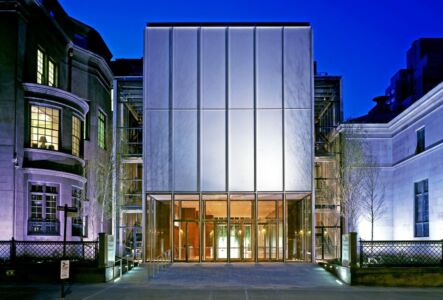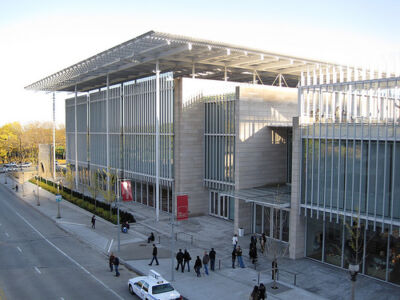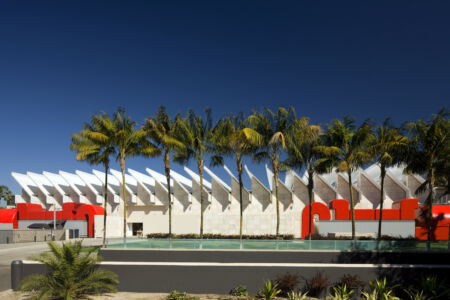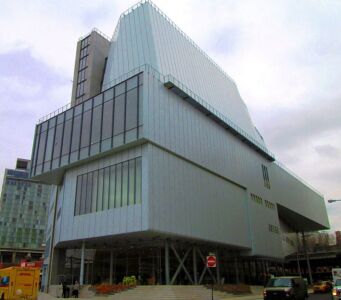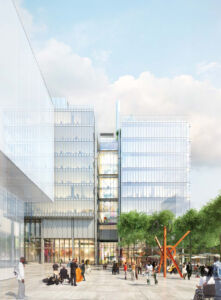As the irascible Mr. Nicolai Ouroussoff—the former New York Times architecture critique–declared on the occasion of the opening of the 2009 Art Institute of Chicago, “America has been suffering from Renzo Piano fatigue.”
Indeed for years R. P. has been capturing all the best commissions, as he built in the United States alone thirteen (much of it expansions and additions) of the total of twenty-four museums he has signed thus far in the world, starting with the modest Houston masterpiece, the magically daylight-modulating De Menil. And of course, he went beyond just museums with, in the first place, his signature building of the New York Times headquarters.
Still according to Ouroussoff, many of Piano’s peers gripe that his success with commissions is due to the subdued nature of his designs — sophisticated but not too threatening or unfamiliar as they seem “tailored to ease the insecurities of museum boards.” Others envy the elegance of his projects, which make him seem equally at home in corporate boardrooms and lofty cultural circles.
If this may be generally true, it certainly is not the case of his most recent museum, the ingenious New Whitney on Gansvoort Street. This building, which reads to me as another “addition” of Piano’s—but this time no less than to Manhattan itself–with its loft-like spaces and projecting “industrial” stairs that connect dramatically cascading metallic platforms, from which to admire some of the most exciting views of New York, just above the iconic ‘High-Line’ it emulates, echoes unapologetically the splendid, brutal vigor of the city.
Before choosing Renzo Piano for the commission, Whitney’s trustees interviewed several other potential architects for the new building, asking each to name a favorite museum. According to Stephen Soba, the Whitney’s director of communications, they all named the Menil. “That clinched the choice.”
This kind of celebration of a small “neighborhood” museum—his first in the United States–seems to validate the “renomée” Piano has acquired in the country, resulting in the important commissions such as the expansions to the Art Institute of Chicago. With its delicate structural frame as a sparkling counterpart to the museum’s 1893 Beaux Arts building, the AIC enhances the exposed art with light-filled galleries–a striking example of the modulation of natural light Piano has consistently refined since the Menil days. The New York’s Morgan Library and Museum, an elegant group of buildings–a “village of memory” as it were–surrounded by the dense urban fabric of Manhattan, ingeniously carves into the underground in response to the exiguity of the site and its overbuilt context; the Science Center in San Francisco along with museum additions in Los Angeles, Boston, Chicago and, if less successfully, the controversial Kimbell in Fort Worth, explain the overwhelming demand for a “go-to” architect.
When the Art Institute opened in 2009, however, at the high point of the “Great Recession”, the question was raised in the media whether the decline of demands of museums in the country would mean an end to Piano’s cornucopia.
The circumstances were not helped by the dark clouds that have been accumulating over his latest commission for the Academy Museum of Motion Pictures. Not only was the first project scraped, but even a law suite has been hanging over Piano as a sward of Damocles due to significant, even fundamental design flaws. As The Los Angeles Times has suggested, “when the Academy Museum of Motion Pictures is finally completed, someone will have to make an understated, Oscar-bait drama to depict the development saga of this troubled project, which after years of languishing in Hollywood finally landed next to LACMA [Los Angeles County Museum of Art] on the Miracle Mile.”
According to The Hollywood Reporter, “first up will be the demolition of the rear addition that was put on the building back in 1946. This will bring the May Co. building back to its original 1939 form and make room for the giant spherical theater and observation deck they’re attaching on the rear. Structural tests have been done to make sure the weight of the 1,000-seat spherical theater can be held in place.”
It is difficult however to expect that the work will be completed by 2017 as initially planned. The question arises more pointedly whether these series of Renzo Piano missteps will confirm the “Piano fatigue”, and open the door of commissions to other capable professionals, in particular among the younger generation, thus braking along, hope against hope perhaps, the hypnotic attraction to sole “Star Architects”.
About Author
Tag
musei , new york , renzo piano
Last modified: 1 Aprile 2017




